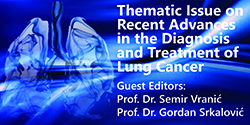Concentration of nitric oxide in patients’ saliva from various metal restorative activities in the oral cavity
Keywords:
Saliva, Nitric oxide, Various metalsAbstract
Objective. Th e aim of this paper is to determine the concentration ofnitric oxide (NO) in the saliva of subjects resulting from the presenceof various metal restorative activities in the oral cavity. Patients andmethods. Th e research was conducted on 20 subjects (12 women and8 men), aged 18-30, with no metal fi llings in their oral cavity and 20subjects (11 women and 9 men) aged 18-30 with prosthetic and conservativework in their oral cavities made of various metals. Th e pHof the saliva was established by means of an “Orion” type pH meter atan optimal temperature of 250C. Th e concentration of NO was determinedby conversion of NO3-2 into NO2-2 with the help of elementaryzinc and then by colorimetric testing of the NO2-2 concentration bymeans of the Griess reagent. Results. Our results established that theconcentration of NO in patients with various metals (60.18±10.24) is33.7% higher, which is statistically insignifi cant, in relation to the controlgroup (45.01±6.28). Conclusion. Various metal restorative activitiesstemming from dentistry practice do not cause changes in the pHvalues of saliva and NO concentrations.References
Moncada S, Palmer RMJ, Higgs EA. Nitric oxide: Physiology, pathophysiology and pharmacology. Pharmacological review. 1991;43(2):109-34.
Krishnan R. Nitric oxide-Friend, basic sciences. Proceedings of a Symposium conducted by the Dept Of Physiology. Calicut Medical College on 13th February 1999.
Michel T, Feron O. Nitric oxide synthesies which, where, how and way? Clin Invest. 1997;100:2446-52.
Moncada S, Higgs EA. Endogenous nitrc oxide: physiology, pathology and clinical relevance. Eur J Clin Invest. 1991;31:361-74.
Carossa S, Pera P, Doglio P, Lombardo S, Colagrande P, Brussino L, Rolla G, Bucca C. Oral nitric oxide during plaque deposition. European Journal of Clinical Investigation. 2001;31:876-9.
Reher VG, Zenóbio EG, Costa FO, Reher P, Soares RV. Nitric oxide levels in saliva increase with severity of chronic periodontitis. J Oral Sci. 2007;49(4):271-6.
Šurdilović D, Stojanović I, Apostolović M. Salivary nitric oxide as biomarker of caries risk in children. Acta Stomatologica Croatica. 2009; 43(1):39-44.
Bodis S, Haregewoin A. Signifi cantly reduced salivary nitric oxide levels in smokers. Annals of oncology. 1994;5:371-72.
Dougal T Hamish, Smith L, Duncan C, Nigel B. The effect of amoxycilin on salivary nitrite concentrations: an important mechanism of adverse reactions? Br J Clin Pharmac. 1995;35:460-2.
Konttinen HK, Platts LA, Eukland KK, Santavirta N, Tornwall J, Sorsa T. Role of nitric oxide in Sjögren syndrome. Arthritis Rheum. 1997;40(5):875-83.
Palmerini CAS, Palombari R, Perieto S, Arienti G. NO synthesis in human saliva. Free Radic Res. 2003;37(1):29-31.
Radegran G, Saltin B. Nitric oxide in the regulation of vasomotor tone in human sceletal muscule. Am J Physiol. 1999;276:1951-60.
Tritsaris K, Looms DK, Nauntoft e B, Dissing S. Nitric oxide synthesis causes inositol phosphate production and Ca2+ release in rat parotid acinar cells. Pfl ugers Arch. 2000;440:233-8.
Anke M, Glei M, Muler R, Dorn W, Vorman J, Anke S. Macro, trace and ultratrace element intake of adults in Europe: problems and dangers? J Commodity Sci. 2000;39:119-39.
Wataha JC, Lockwood PE. Release of elements from dental casting alloy into cell-culture medium over 10 month. Dent Mater. 1998;14:158-63.
Karov J, Hinberg I. Galvanic corrosion of selected dental alloys. J Oral Rehabil. 2001;28(3):212-9.
Baričević M, Mravak-Stipetić M, Stanimirović A, Lončar B, Andabak A, Baričević D. Salivary concentrations of nickel and chromium in patients with burning mouth syndrome. Acta Dermatovenerol Croat. 2011;19(1):2-5.






